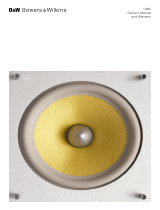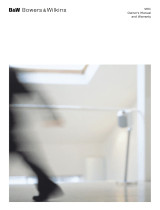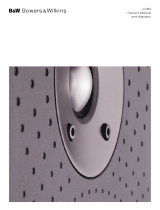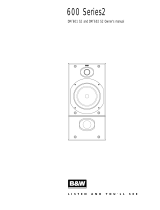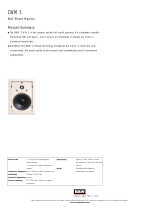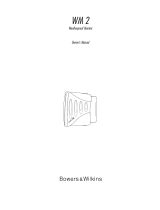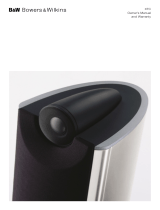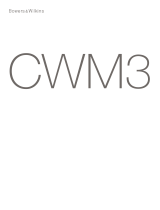Page is loading ...

Custom InWall
CWM Cinema 6
Installation Manual

Contents
English
Owner’s Manual............2
Limited Warranty...........4
Français
Manuel d’utilisation.......5
Garantie limitée.............7
Deutsch
Bedienungsanleitung.....8
Garantie .....................11
Español
Manual de
instrucciones ..............12
Garantía limitada.........15
Português
Manual do utilizador....16
Garantia limitada.........18
Italiano
Manuale di istruzioni ...19
Garanzia limitata .........22
Nederlands
Handleiding ................23
Garantie .....................25
Ελληνικά
Ãδηγίες Ìρήσεως ....26
Περιïρισµένη
εγγύηση....................29
Русский
Руководство по
эксплуатации ............30
Ограниченная
гарантия....................33
"esky
Návod k pouãití..........34
Záruka .......................37
Polski
Instrukcja
uÃytkownika ...............38
Gwarancja .................40
.....................41
.......................
43
.......................44
.......................46
EU Declarations of
Conformity..................50
Technical
Specifications........51-52
CWM Cine 6 man Inside2.qxd 8/11/07 09:58 Page 1

English
Owner’s manual
Dear customer,
Thank you for choosing B&W. Please read this manual
f
ully before unpacking and installing the product. It will
help you to optimise its performance. B&W maintains
a network of dedicated distributors in over
6
0 countries who will be able to help you should
you have any problems your dealer cannot resolve.
Environmental Information
All B&W pro
ducts are designed to
comply with international directives on
t
he Restriction of Hazardous Substances
(RoHS) in electrical and electronic equipment and the
disposal of Waste Electrical and Electronic Equipment
(WEEE). These symbols indicate compliance and that
the products must be appropriately recycled or
processed in accordance with these directives.
Consult your local waste disposal authority for
guidance.
Carton Contents
Check in the carton for:
Wall frame/baffle with driver units and crossover unit
Grille with backing scrim fabric
Paint Mask
Mounting template
Introduction
The CWM Cinema 6 is primarily intended for home
theatre application as a centre channel speaker but it
may equally well be used as front left and right or
surrounds or for 2-channel audio.
No matter how good the speakers themselves, they
will not deliver their full potential unless properly
installed. Please read through this manual fully. It will
help you optimise their performance.
The CWM Cinema 6 speaker may be installed during
construction of the studwork wall or at a later date. If
possible, installation during construction of the wall is
preferred however the CWM Cinema 6 pre-mount kit
will be required.
Speaker Positioning
Check that there is no conflict with other installations
(pipe work, air conditioning, power cabling etc.). In
existing drywall construction, use a stud-finding tool to
map the construction accurately and a pipe detector
to scan the proposed installation position.
Refer to the section drawing of the speaker and ensure
that there is enough clearance behind the plasterboard
(sheetrock) for the clamps to swing out fully.
Avoid installing the speakers in the same cavity as
flimsy ducting, which may be induced to rattle.
The speakers are designed to operate satisfactorily in
a wide range of cavity volumes, ideally above 20 litr
es
(0.8 cu ft), so make sure the volume is not too
r
estricted by cr
oss studs.
I
n solid wall construction, be prepared to provide a
cavity in the wall that extends outside the boundaries
o
f the speaker's frame, otherwise bass performance
will be compromised.
The speakers are balanced for half-space mounting
(
ie flush in a wall, ceiling or soffit). Placement near a
w
all/ceiling junction or in a corner may give rise to too
much bass and a boomy quality to the sound. Try to
k
eep the speakers at least 0.5m (20in) from wall/ceiling
edges.
The following sections give guidance on optimum
positioning, but this may be modified in line with
domestic constraints.
Home Theatre Centre Channel Applications
T
he ideal position for a centre channel speaker is
behind the centre of the screen, however this can only
be realised when using an acoustically transparent
projection screen. In most cases the centre speaker will
be positioned in a laterally central position either directly
above or directly below the screen. Choose the position
that is nearest ear height. Figure 1 illustrates these
positioning guidelines.
Home Theatre Front Channel Applications
and 2-channel audio
For multi-channel home theatre the left and right
speakers should be approximately 0.5m (20 in) to the
left and right of the screen and as near the centre
height of the screen as possible. Figure 2 illustrates
these positioning guidelines.
Best imaging for stereo is obtained when the speakers
are mounted in the wall approximately at ear height and
making an angle between 40º and 60º at the centre of
the listening position.
Home Theatre Surround Channel
Applications
The speakers should be positioned 60cm (2 ft) or more
above head height.
5.1 Channel: The horizontal angle to the centre of the
listening position should be approximately 120º round
from the centre of the screen. Figure 3.1 illustrates this
arrangement.
6.1 Channel: Position two speakers to the sides in line
with the centre of the listening area and one centrally
behind the listeners Figur
e 3.2 illustrates this
arrangement.
7.1 Channel: Position two speakers to the sides in line
with the centre of the listening area and two behind the
listeners, subtending an angle of approximately 40º.
Figure 3.3 illustrates this arrangement.
Stray Magnetic Fields
The speaker drive units create stray magnetic fields
that extend beyond the boundaries of the cabinet. We
r
ecommend you keep magnetically sensitive articles
(CR
T television and computer screens, computer
discs, audio and video tapes, swipe cards and the
like) at least 0.5m (20 in) fr
om the speaker
. LCD and
plasma screens are not affected by magnetic fields.
2
CWM Cine 6 man Inside2.qxd 8/11/07 09:58 Page 2

Preparing For Installation
Choosing cable
Excessive resistance in the speaker cable wastes
p
ower and alters the frequency response of the
speaker. Always try to keep the resistance as low as
possible with the loop resistance preferably below 0.5
o
hms for non-critical applications and below 0.2 ohms
for best results. Use the table of figure 7 to calculate
t
he minimum gauge of cable required.
F
itting The Wall Frame/Baffle (existing wall
c
onstruction/retrofit)
Figure 4 illustrates this procedure.
Position the template at the desired location of the
speaker. The template is marked with both vertical and
h
orizontal centre lines to aid alignment.
Trace round the outer edge of the template and cut
neatly just inside the line.
To improve the mechanical integrity of the wall and
reduce the likelihood of rattles, we recommend you
apply a bead of mastic/caulking along the joints
between the back of the plasterboard (sheetrock) and
the studs in the vicinity of the speaker.
Run the cable to the aperture, allowing enough length
to comfortably connect the speaker, but not too much,
as the excess may rattle against the structure.
Fitting the Wall Frame/Baffle (new drywall
construction)
Figure 5 illustrates this procedure.
The speaker can be installed once the wall is
completed in the same manner as retrofitting, but it is
easier to position and cut the hole if the optional pre-
mount kit (PMK) is used before the plasterboard is
fitted.
Staple or nail the PMK to the studs as described in the
instructions with the kit. Run the cable and secure it to
the fixing point on the PMK. Allow enough length to
comfortably connect the speaker, but not too much, as
the excess may rattle against the structure.
Results are affected by how well the plasterboard
(sheetrock) is attached to the studs and we
recommend you apply a bead of mastic/caulking as
well as screwing or nailing the panels to the studs in
the vicinity of the speaker.
Once the board is fitted, the inner flange of the PMK
serves as a guide for a hole router or saw.
If extra acoustic isolation to adjoining rooms is required
or some protection against the spread of fire, use the
optional back box in place of the PMK. Follow the
instructions with the back box for fitting and running
the cable.
When fitting the plasterboard (sheetrock), use
mastic/caulking between the sheets and the back box
to avoid rattles. Rout or saw out the speaker aperture
using the back-box flange as a guide. Depending on
the diameter of the router, you may need to square off
the cor
ners with a saw
.
F
itting the Wall Frame/Baffle (solid wall
construction)
I
n order for the bass performance not to be
c
ompromised, the speaker requires a cavity volume of
at least 20 litres (0.8 cu ft). This means that, in a
s
tandard 10cm (4 in) thick wall, the cavity will extend
b
eyond the boundaries of the speaker frame. It is
possible to provide this cavity simply by using a lintel,
c
overing the hole with plasterboard (sheetrock) and
fitting the speaker as described above for retrofitting
into a drywall. (Figure 6) However, the back box
p
rovides a useful means of defining a minimum volume.
Follow the instructions with the back box for fitting and
running the cable. If using a wet plaster finishing
m
ethod, first apply a thin layer of PVA adhesive
(polyvinyl-based caulking) onto the back box before
plastering to avoid rattles as a result of the plaster
shrinking away from the back box as it dries.
If using plasterboard (sheetrock), stick the sheets to
the surfaces of the back box using flexible
mastic/caulking. Rout out the aperture using the flange
as a guide. Depending on the diameter of the router,
you may need to square off the corners with a saw.
In all cases, we recommend not using cement or
mortar to fix the back box into the brick or block-work.
Rattles are best avoided by using flexible
mastic/caulking and wedges.
Damping the Wall Cavity
Fill the wall cavity or back box, but not the space
immediately behind the speaker, with unlined fibreglass
or mineral wool matting. The packing density should be
just enough to comfortably prevent the material from
dropping or sagging over time. In an open wall cavity,
fill to a distance of at least 30cm (1 ft) above and
below the speaker.
IMPORTANT: Ensure that the materials you use meet
local fire and safety regulations.
Connecting and Fitting the Speaker
(all installation types)
All connections should be made with the equipment
switched off.
Connect the cable, observing the correct polarity.
With the grille removed, position the speaker in the
aperture and screw in the 6 screws visible from the
front. These screws automatically swing out clamping
dogs that locate behind the mounting surface. Ensure
that they have located pr
operly before fully tightening
the screws. A certain amount of flexing of the frame is
allowed to take up unevenness in the mounting
surface, but do not over
-tighten the scr
ews as
excessive distortion of the speaker frame may result.
Customising
The frame has a paintable white semi-matte finish,
ready if necessary to be re-finished to match room
decor
. Fit the paint mask befor
e r
e-finishing. Do not
re-finish the drive units or baffle area behind the grille.
Avoid touching the drive units, as damage may result.
3
CWM Cine 6 man Inside2.qxd 8/11/07 09:58 Page 3

B
efore painting the grille, peel off the fabric scrim from
the back, otherwise the pores will get clogged and the
s
ound will be impaired. If the scrim does not stay in
place properly when replaced, spray the back of the
g
rille mesh (NOT the scrim) with a light coating of 3M
S
prayMount adhesive or similar.
Fine Tuning
I
f the sound is too bright, increasing the amount of
s
oft furnishing in the room (heavier curtains for
example) may help balance the sound. Conversely,
r
educing the amount of soft furnishing may help
brighten a dull sound.
S
ome rooms suffer from “flutter echoes” – echoes that
"bounce" between parallel room boundaries. Flutter
echoes can colour the sound of the speakers in the
room. Test for flutter echoes by standing in the middle
of the room and clapping your hands. Flutter echoes
can be reduced by placing irregular shaped items or
non-reflective surfaces – bookshelves, rugs or pictures
for example – on one of the offending walls or floor.
Running-in Period
The performance of the speaker will change subtly
during the initial listening period. If the speaker has
been stored in a cold environment, the damping
compounds and suspension materials of the drive
units will take some time to recover their correct
mechanical properties. The drive unit suspensions will
also loosen up during the first hours of use. The time
taken for the speaker to achieve its intended
performance will vary depending on previous storage
conditions and how it is used. As a guide, allow up to
a week for the temperature effects to stabilise and
15 hours of average use for the mechanical parts to
attain their intended design characteristics.
However, longer run-in periods (as long as a month)
have been reported and there is evidence to suggest
that this has little to do with the speaker changing and
more to do with the listener getting used to the new
sound. This is especially so with highly revealing
speakers such as these where there may be a
significant increase in the amount of detail compared
with what the listener has previously been used to; the
sound may at first appear too "up front" and perhaps
a little hard. After an extended period of time the
sound will seem to mellow, but without losing clarity
and detail.
Limited Warranty
This pr
oduct has been designed and manufactured to
the highest quality standards. However, if something
does go wrong with this product, B&W Group Ltd. and
its national distributors warrant free of charge labour
(exclusion may apply) and r
eplacement parts in any
country served by an official B&W distributor.
This limited warranty is valid for a period of five years
from the date of purchase or two years for electronics
including amplified loudspeakers.
Terms and Conditions
1 The warranty is limited to the repair of the
e
quipment. Neither transportation, nor any other
costs, nor any risk for removal, transportation and
installation of products is covered by this warranty.
2 This warranty is only valid for the original owner. It
i
s not transferable.
3
This warranty will not be applicable in cases other
than defects in materials and/or workmanship at
t
he time of purchase and will not be applicable:
a
. for damages caused by incorrect installation,
connection or packing,
b. for damages caused by any use other than correct
use described in the user manual, negligence,
m
odifications, or use of parts that are not made or
authorised by B&W,
c. for damages caused by faulty or unsuitable
ancillary equipment,
d. for damages caused by accidents, lightning, water,
fire heat, war, public disturbances or any other
cause beyond the reasonable control of B&W and
its appointed distributors,
e. for products whose serial number has been
altered, deleted, removed or made illegible,
f. if repairs or modifications have been executed by
an unauthorised person.
4 This guarantee complements any national/regional
law obligations of dealers or national distributors
and does not affect your statutory rights as a
customer.
How to claim repairs under warranty
Should service be required, please follow the following
procedure:
1 If the equipment is being used in the country of
purchase, you should contact the B&W authorised
dealer from whom the equipment was purchased.
2 If the equipment is being used outside the country
of purchase, you should contact the B&W national
distributor in the country of residence who will
advise where the equipment can be serviced. You
can call B&W in the UK or visit our web site to get
the contact details of your local distributor.
To validate your warranty, you will need to produce the
warranty booklet completed and stamped by your
dealer on the date of purchase. Alternatively, you will
need the original sales invoice or other proof of
ownership and date of pur
chase.
4
CWM Cine 6 man Inside2.qxd 8/11/07 09:58 Page 4

46
CWM Cine 6 man Inside2.qxd 8/11/07 09:59 Page 46

CWM Cinema 6
50
CWM Cine 6 man Inside2.qxd 8/11/07 09:59 Page 50

CWM Cinema 6
T
echnical features
Description
Drive units
Frequency response
Frequency range
Sensitivity
Nominal impedance
Crossover frequency
Maximum recommended
amplifier power
Frame size
Cut-out size
Min. depth required
Net weight
Nautilus
™
tube-loaded tweeter
Woven glassfibre bass/midrange driver
2-way in-wall speaker system
1x ø25mm (1 in) tube-loaded softdome high-frequency
2x ø160mm (6 in) woven glassfibre cone bass/midrange
60Hz - 22kHz ±3dB on reference axis
-6dB at 50Hz and 30kHz
92dB spl (2.83V, 1m)
8
Ω
(minimum 5.0
Ω
)
3.5kHz
150W continuous into 8
Ω
on unclipped programme
Height: 255mm (10.1 in)
Width: 369mm (14.6 in)
Height: 217mm (8.5 in)
Width: 332mm (13.1 in)
90mm (3.6 in) behind ceiling surface
8mm (0.3 in) in front of ceiling surface
2.9kg (6.4 lb)
52
CWM Cine 6 man Inside3.qxd 9/4/08 11:22 Page 52

Nautilus is a trademark of B&W Group Ltd.
Copyright © B&W Group Ltd. E&OE
Printed in China.
B&W Group (UK Sales)
T +44 1903 221 500
B&W Group North America
T +1 978 664 2870
B&W Group Asia Ltd
T +852 2 869 9916
B&W Group Ltd
Dale Road
Worthing West Sussex
BN11 2BH England
T +44 (0) 1903 221 800
F +44 (0) 1903 221 801
info@bwgroup.com
www.bowers-wilkins.com
II11759 Issue 3
/
